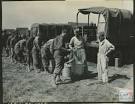 The United States entry into World War II was a difficult time, especially as the draft board began calling up men for military service. This appeal letter was written on behalf of my father by his employer.
The United States entry into World War II was a difficult time, especially as the draft board began calling up men for military service. This appeal letter was written on behalf of my father by his employer.
January 16, 1941
SELECTIVE SERVICE LOCAL BOARD:
I am asking for your consideration in classifying Harvey Simmelink, who is in my employ as manager of the Manlius Milk Products Company of Manlius, Illinois. My reason for doing so is that I am not in a position to replace Mr. Simmelink with a man that will be able to operate that plant as he is.
It takes years of special training to learn to make a quality cheese which the trade demands today. Besides that, Mr. Simmelink has the acquaintance, personality and the respect that is required of a manager to make a plant like the one he is in charge of operate successfully in its respective community. The experience and qualifications Mr. Simmelink possesses are outstanding in his profession and he would not be very easily replaced, if at all.
I would be the last one to claim exemption for any of my help which could readily be replaced, but in this particular case it is otherwise. Harvey Simmelink has been in my employ for better than five years and it is through his efforts that the Manlius Plant has served that community as well as it has.
In view of the fact that Mr. Simmelink’s work consists of manufacturing food product which is of vital importance, I trust you will consider my request in classifying Mr. Simmelink so he will be allowed to remain in his present position.
Respectfully yours,
Axel Madsen
The letter and an appeal hearing delayed Dad’s induction but he was eventually drafted into the Army in 1942.
Photo from National WWII Museum







